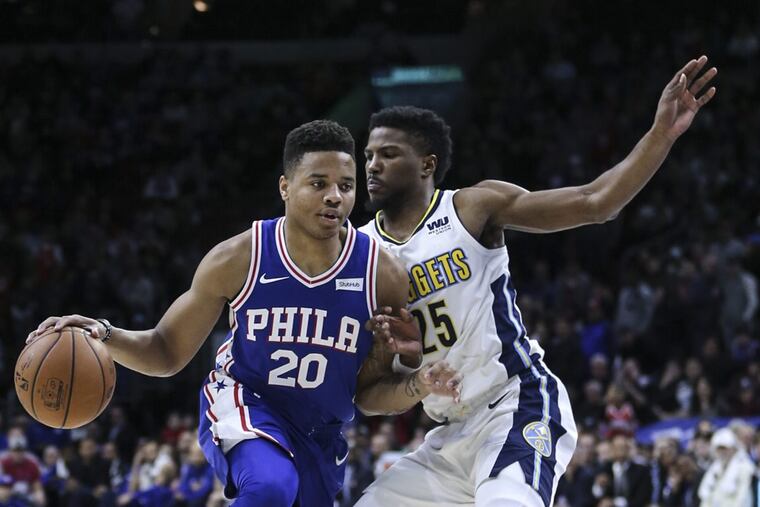Against Nuggets, Fultz looks like a player who can help | David Murphy
Markelle Fultz gives the Sixers a dimension they need as they turn their attention to the NBA playoffs.

They saw him from the moment he stood up. On the court, there was a lull in the action, but on the sidelines, something was happening that had not occurred since late October. Markelle Fultz rose from his folding chair and a noisy swell of recognition followed in his wake, a rippling crescendo rising through the seats behind the Sixers' bench. By the time the horn buzzed, the murmur had erupted into a roar, 20,585 rising to their feet as the No. 1 overall pick in the 2017 draft made his long-awaited return to the court.
In a lot of ways, Monday wasn't much different from the days that had preceded it in the saga of Markelle Fultz. There were few concrete answers from anyone about anything regarding the condition that forced the rookie to take five months off to relearn his shooting motion. Brett Brown spoke for about 10 minutes on the topic, and Bryan Colangelo spoke for 20, and all we really learned was what we already knew. For five months, Fultz wasn't able to play. And then, on Monday, he was.
The exact details of what happened in between will have to wait for a later date. Fultz, too, avoided any talk about the condition that had led to his absence, responding to a couple of questions about his shoulder with silence. Even the method by which his teammates learned of his return were subject to obfuscations by the players who were asked.
This lack of transparency is easy to project incompetence or malfeasance onto the organization's handling of the situation, but a more obvious explanation is that nobody was 100 percent certain what it was they were dealing with. The mind-body connection can sometimes defy our best attempts at medical science. Even the greatest of diagnosticians is largely at the mercy of self-reported symptoms.
At this point, the thing that matters most is that he is back on the court, and the last nine games of the regular season will give us our longest look at what he has to offer. Whether he has enough time to establish a role in a playoff rotation remains to be seen. But in his 14 minutes against the Nuggets, you saw why the Sixers are determined to find out.
"He's different from anything we have," Brown said.
You saw that with a spin move he made in the paint with a couple of minutes left in the third quarter, and, later, on an off balance finish at the rim that gave the Sixers an 81-74 lead. You saw it in the length he enables the Sixers to maintain on the defensive side when Ben Simmons checks out. And, yes, you saw it in the two midrange jumpers he buried off the dribble in the closing minutes of a 123-104 win.
By the time it was over, Fultz had scored 10 points on 5-of-13 shooting with eight assists, four rebounds. Perhaps most significant were the 16 points by which the Sixers outscored the Nuggets when he was on the court. There was clearly some rust: a turnover on one of his first touches, a couple of ill-advised pull-ups that his defender got a hand on. Still, plus-16 is plus-16: at the very least, Fultz's presence did not hurt.
Yet it was more impressive than that. By the time the final horn sounded, you understood why the Sixers felt like it could not hurt to throw him out there. He was smooth, confident, in control on the dribble and off of it.
"He showed signs of why he was the first player chosen," Brown said. "Obviously, the game is fast, and elite at this stage, and that's a good team, but the night could not have worked out better."
There are still plenty of questions to answer regarding the player Fultz is today versus the one he was when the Sixers drafted him. Prior to the game, Colangelo steered questions about the status of Fultz's jump shot to the other attributes he brings to the court.
"He didn't have a lot of catch-shoot situations at Washington," the Sixers president said. "He had a lot of shot creation opportunities that he either created himself, or was off the bounce, or was penetrating and kicking to a shooter. But most of his shots came with motion. I'm not sure he's a catch-and-shoot type of player, necessarily. Just looking at the game and how Ben Simmons impacts the game without really catching and shooting — I don't think I've seen Ben take a catch-and-shoot shot unless it was a late-clock situation and he was throwing it up . . ."
At the same time, Colangelo traded one of his most valuable assets to draft Fultz because his skill set was a complement to Simmons, rather than a replication. At Washington, he averaged five three-point attempts per game; part of what made him attractive to the Sixers was his range. No doubt, there is an opening on this team for a back-up point guard who can create his own shot and finish at the rim and bring some length and athleticism when Simmons is on the bench. But Fultz was drafted to be a lot more than that, and his long-range jumper is a critical piece.
For now, though, there is reason to be encouraged by a performance like Monday night's. At 43-30 and in fourth place in the Eastern Conference, the Sixers have a lot to play for in the here and now. The early returns suggest that Fultz can be a player who can help.